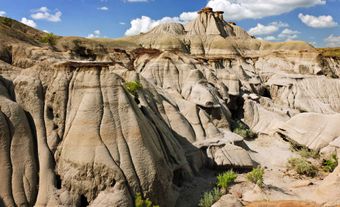Esker
An esker is a ridge (Gaelic eiscir, "ridge") of gravel and sand emplaced during glacial melt by the deposition of sediments from meltwater rivers flowing on the ice (channel fills) or beneath a glacier (tunnel fills). Their orientation is affected by various factors, but generally they are parallel to the ice flow and tunnel fills may indicate upslope water flow under hydraulic pressure from the overlying ice. Sediment grain size varies from sand to coarse gravel, suggesting that meltwater in the ice tunnel flowed swiftly, maintaining finer-grained sediments in suspension. Settled sediments collapse to the angle of repose (i.e., the steepest slope at which loose material will stand, about 30°). Ridges are often narrow and sinuous, but may also be broad and flat-topped, have multiple crests, or are segmented like a string of beads. Beaded eskers were deposited in segments, each ending in a delta formed in a proglacial lake (i.e., a lake formed beside the margin of a GLACIER).
In size eskers are highly variable. Two of the largest in Canada are the Thelon esker in the Northwest Territories and Nunavut (almost 800 km long) and the Munro esker near Munro Lake in northern Ontario (250 km long and almost 5 km wide). In contrast, many eskers are a few kilometres in length, approximately 100 m wide and up to 50 m high. One of the world's best areas to observe eskers is the mining region of northwest Québec, where many eskers, generally aligned north-south, were emplaced during the last deglaciation.
Eskers do not generally survive from one GLACIATION to another. They are features of a deglaciation phase and are usually destroyed when ice re-advances over them. Eskers form good, confined aquifers (water-bearing strata) when covered by fine, impermeable sediments. Esker sediments help locate ore deposits upstream from a ore-indicator-bearing esker bed (seePROSPECTING).

 Share on Facebook
Share on Facebook Share on X
Share on X Share by Email
Share by Email Share on Google Classroom
Share on Google Classroom


